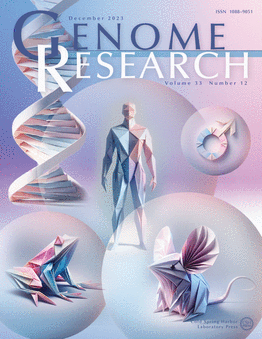Characterization of DNA methylation reader proteins of Arabidopsis thaliana
IF 6.2
2区 生物学
Q1 BIOCHEMISTRY & MOLECULAR BIOLOGY
引用次数: 0
Abstract
In plants, cytosine DNA methylation (mC) is largely associated with transcriptional repression of transposable elements, but it can also be found in the body of expressed genes, referred to as gene body methylation (gbM). gbM is correlated with ubiquitously expressed genes; however, its function, or absence thereof, is highly debated. The different outputs that mC can have raise questions as to how it is interpreted—or read—differently in these sequence and genomic contexts. To screen for potential mC-binding proteins, we performed an unbiased DNA affinity pull-down assay combined with quantitative mass spectrometry using methylated DNA probes for each DNA sequence context. All mC readers known to date preferentially bind to the methylated probes, along with a range of new mC-binding protein candidates. Functional characterization of these mC readers, focused on the MBD and SUVH families, was undertaken by ChIP-seq mapping of genome-wide binding sites, their protein interactors, and the impact of high-order mutations on transcriptomic and epigenomic profiles. Together, these results highlight specific context preferences for these proteins, and in particular the ability of MBD2 to bind predominantly to gbM. This comprehensive analysis of Arabidopsis mC readers emphasizes the complexity and interconnectivity between DNA methylation and chromatin remodeling processes in plants.拟南芥DNA甲基化解读蛋白的研究
在植物中,胞嘧啶DNA甲基化(mC)在很大程度上与转座因子的转录抑制有关,但它也可以在表达基因体内发现,称为基因体甲基化(gbM)。gbM与普遍表达的基因相关;然而,它的功能,或缺乏,是高度争议的。mC可能具有的不同输出提出了在这些序列和基因组环境中如何解释或读取不同的问题。为了筛选潜在的mc结合蛋白,我们使用甲基化DNA探针对每个DNA序列上下文进行了无偏DNA亲和下拉分析和定量质谱分析。迄今为止已知的所有mC读取器优先结合甲基化探针,以及一系列新的mC结合蛋白候选物。这些mC读取器的功能特征,主要集中在MBD和SUVH家族,是通过ChIP-seq定位全基因组结合位点,它们的蛋白质相互作用物,以及高顺序突变对转录组和表观基因组谱的影响进行的。总之,这些结果突出了这些蛋白质的特定环境偏好,特别是MBD2主要与gbM结合的能力。这项对拟南芥mC阅读器的综合分析强调了植物中DNA甲基化和染色质重塑过程之间的复杂性和互联性。
本文章由计算机程序翻译,如有差异,请以英文原文为准。
求助全文
约1分钟内获得全文
求助全文
来源期刊

Genome research
生物-生化与分子生物学
CiteScore
12.40
自引率
1.40%
发文量
140
审稿时长
6 months
期刊介绍:
Launched in 1995, Genome Research is an international, continuously published, peer-reviewed journal that focuses on research that provides novel insights into the genome biology of all organisms, including advances in genomic medicine.
Among the topics considered by the journal are genome structure and function, comparative genomics, molecular evolution, genome-scale quantitative and population genetics, proteomics, epigenomics, and systems biology. The journal also features exciting gene discoveries and reports of cutting-edge computational biology and high-throughput methodologies.
New data in these areas are published as research papers, or methods and resource reports that provide novel information on technologies or tools that will be of interest to a broad readership. Complete data sets are presented electronically on the journal''s web site where appropriate. The journal also provides Reviews, Perspectives, and Insight/Outlook articles, which present commentary on the latest advances published both here and elsewhere, placing such progress in its broader biological context.
 求助内容:
求助内容: 应助结果提醒方式:
应助结果提醒方式:


